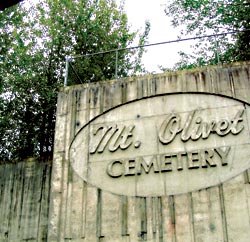The Otis family of Kent and the McNeal family of Tacoma met for the first time on a day in 2004, staring at each other across a grave site in Renton. It was an unsettling introduction. They were strangers who had come to visit the resting place of their sons, both of them teenagers, both of them victims of crime, and both of them, the families had just learned, buried in the same grave.
The McNeal’s son, Terrell Porter McNeal, 19, of Tacoma, had been shot while visiting in Los Angeles on Dec. 31, 2003. The Otises’ son, Johnathan Lee Otis, 17, was slain Jan. 3, 2004, in a parking lot in the Des Moines area. Like their families, they had never met in life. But they were unexpectedly united in death.
“We were speechless when we found out,” says Terrell’s father Terry McNeal. “This would have never happened if the cemetery put them in separate graves like each family expected, instead of being sneaky about it.” Similarly dumbfounded, Johnathan’s mother, Ruby Otis, said in a complaint to the state, “They buried my son, then left the grave open for a couple of days, then buried another person on top of my son without ever notifying us.”
The two families learned about the double burial only by chance. A friend of the Otises who attended young Johnathan’s burial ceremony on Jan. 9 also was a friend of the McNeals and attended the burial of young Terrell on Jan. 13. Grim as it was attending two funerals for two teen crime victims in four days, the woman was even more distraught after she walked up to the same grave site the second time. No name markers or headstones identified the grave yet. But she was sure it was the same plot, and filmed a video of the services. A week later, she contacted both families, and they subsequently met at the graveyard, Mount Olivet Cemetery in Renton.
They shook their heads. Now they understood why someone was leaving flowers and mementoes that each family found strange, including a T-shirt imprinted with the photo of another boy. Both families would arrive, find the tributes, and move them, certain someone had honored the wrong grave. Ruby Otis, who couldn’t be reached for this story, said in her complaint that when the friend called to alert her, she drove straight to the cemetery that Sunday morning. “I went to the grave site and apologized to Terrell for moving his stuff and lit two candles for Johnathan and Terrell,” she wrote.
On the day the two families met, they went together to the caretaker’s office. According to Otis, the caretaker “apologized and stated that they were wrong for not notifying us about any of this.” However, the cemetery owner told both families at a later meeting they had signed contracts that allowed multiple burials in a single grave, and if they wanted one of the teens’ remains moved, they’d have to come up with more money. Ruby Otis, whose son, Des Moines police say, had been murdered in a parking lot in a gang-related shooting that remains unsolved, sought legal action against the cemetery.
Terry McNeal, meanwhile, says he was dazed and angry. “I look at Terrell’s picture every day,” McNeal said in a recent interview, speaking of the son killed during an argument in the front yard of an L.A. home he was visiting; the shooter was arrested after a standoff with police. “Terrell has a girl that just turned four last week. You never expect to bury your kids. When this happens, you’re very vulnerable. It’s sad that people take advantage of people in that situation.”
Both families say Mount Olivet failed to clearly disclose the likelihood that another person could be buried in their sons’ grave. Copies of the two contracts show the families each were charged $1,595 for “single burial use of multiple interment space.” Otis’ contract lists burial in Section E, Row 4, Space 4; McNeal’s contract, inked days later, lists the burial spot as Section E, Row 4, Space 4T-T meaning on Top. (The Otis’ contract had no similar symbol, such as B for Below). State law allows multiple burials in one grave, but the consumer is to be made fully aware of that possibility. Says McNeal: “The cemetery never brought it up,” and the T meant nothing. The contract language of “single burial…multiple interment…” he says, can easily mislead a buyer who is not in a state of mind to comprehend contract language.
The Otis and McNeal families both filed complaints with the state, which investigated. The case was closed when all sides came to an agreement, and Terrell’s body was exhumed and buried elsewhere in the cemetery at no additional cost to the McNeals. A spokesperson for Mount Olivet, in a recent interview, said he didn’t want to comment further except to say, “The entire matter was resolved,” and that multiple burials in a single grave “are common practice.” But prompted in part by this incident, the legislature last year approved a new law requiring contracts to include clear language stating multiple interment “means two or more noncremated human remains are buried in the ground, in outer burial enclosures or chambers, placed one on top of another….”
Public records show the cemetery paid Ruby Otis $6,400 to drop any legal claims against Mount Olivet, which admitted no liability but promised not to bury any more bodies in Johnathan’s grave. Terry McNeal says he received no payment but was satisfied with the reburial of Terrell. “We just wanted it like it was supposed to be the first time,” he says. “It was about respect and principle, and having a nice spot where we can go and visit our son, alone.”









